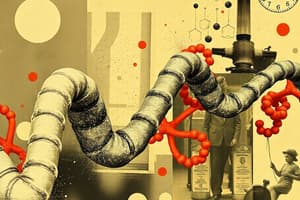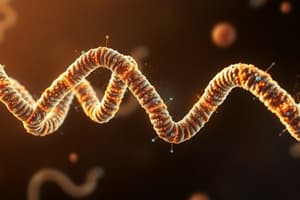Podcast
Questions and Answers
Ionic interactions involve negatively charged groups interacting with positively charged ______.
Ionic interactions involve negatively charged groups interacting with positively charged ______.
groups
Hydrophobic side chains aggregate on the inside of the protein while hydrophilic side chains are on the ______.
Hydrophobic side chains aggregate on the inside of the protein while hydrophilic side chains are on the ______.
outside
Proteins composed of a single polypeptide do not have ______ structure.
Proteins composed of a single polypeptide do not have ______ structure.
quaternary
The proteins known as ______ assist in the proper folding of other proteins during synthesis.
The proteins known as ______ assist in the proper folding of other proteins during synthesis.
Chaperones keep proteins ______ until the synthesis process is finished.
Chaperones keep proteins ______ until the synthesis process is finished.
Denaturation involves the unfolding of protein secondary and tertiary structure without hydrolysis of ______ bonds.
Denaturation involves the unfolding of protein secondary and tertiary structure without hydrolysis of ______ bonds.
Proteins with two or more polypeptides are said to have a ______ structure.
Proteins with two or more polypeptides are said to have a ______ structure.
Denatured proteins are usually ______ and precipitate from solution.
Denatured proteins are usually ______ and precipitate from solution.
The first step in the folding process involves the formation of ______ structures.
The first step in the folding process involves the formation of ______ structures.
Amyloidosis is a group of diseases occurring due to the aggregation of ______.
Amyloidosis is a group of diseases occurring due to the aggregation of ______.
Positive and negative side chains attract each other, while similar charges are kept out of ______.
Positive and negative side chains attract each other, while similar charges are kept out of ______.
Improperly folded proteins are usually ______ in the cell.
Improperly folded proteins are usually ______ in the cell.
A monomeric protein consists of a single polypeptide folded into secondary and ______ structures.
A monomeric protein consists of a single polypeptide folded into secondary and ______ structures.
Different secondary structures are connected by ______.
Different secondary structures are connected by ______.
Globular proteins are compact with a high density ______.
Globular proteins are compact with a high density ______.
A domain consists of different ______ structural elements.
A domain consists of different ______ structural elements.
Folding of one domain is independent of other domains on the same ______.
Folding of one domain is independent of other domains on the same ______.
Interactions stabilizing tertiary structure include covalent, ionic, and ______ interactions.
Interactions stabilizing tertiary structure include covalent, ionic, and ______ interactions.
Disulfide bonds are produced from oxidation of the –SH group of two ______ residues.
Disulfide bonds are produced from oxidation of the –SH group of two ______ residues.
Non-polar amino acids are located on the ______ of the protein.
Non-polar amino acids are located on the ______ of the protein.
Hydrogen bonds are formed between amino acid side chains with oxygen- or nitrogen-bound ______.
Hydrogen bonds are formed between amino acid side chains with oxygen- or nitrogen-bound ______.
Proteins are composed of ______ attached by peptide bonds.
Proteins are composed of ______ attached by peptide bonds.
The four hierarchies of protein structure are primary, secondary, ______, and quaternary.
The four hierarchies of protein structure are primary, secondary, ______, and quaternary.
A peptide bond is an amide link between the α-carboxyl group of one amino acid and the α-______ group of another.
A peptide bond is an amide link between the α-carboxyl group of one amino acid and the α-______ group of another.
The N-terminal is written to the left and the C-______ is written to the right.
The N-terminal is written to the left and the C-______ is written to the right.
Each amino acid component of a peptide chain is called a ______.
Each amino acid component of a peptide chain is called a ______.
Hydrogen bonds are parallel to the ______ in an α-helix.
Hydrogen bonds are parallel to the ______ in an α-helix.
A β-sheet can be formed from two or more different ______, or from the same polypeptide.
A β-sheet can be formed from two or more different ______, or from the same polypeptide.
β-bends also called ______ turns, reverse the direction of a polypeptide chain.
β-bends also called ______ turns, reverse the direction of a polypeptide chain.
The α-helix contains about ______ amino acids per turn.
The α-helix contains about ______ amino acids per turn.
Proline is known to disrupt the ______ structure due to its unique structure.
Proline is known to disrupt the ______ structure due to its unique structure.
Antiparallel sheets have polypeptide chains arranged with N- and C-______ alternating.
Antiparallel sheets have polypeptide chains arranged with N- and C-______ alternating.
Nonrepetitive secondary structures have less repetitive structure than ______ and sheets.
Nonrepetitive secondary structures have less repetitive structure than ______ and sheets.
Ionic interactions may affect the stability of α-helices and ______ in proteins.
Ionic interactions may affect the stability of α-helices and ______ in proteins.
The only charged groups on a polypeptide are found at the N-terminal α-______ group and the C-terminal α-carboxyl group.
The only charged groups on a polypeptide are found at the N-terminal α-______ group and the C-terminal α-carboxyl group.
Flashcards are hidden until you start studying
Study Notes
Protein Structure
- Proteins are composed of amino acids linked by peptide bonds.
- Proteins have four levels of structure: primary, secondary, tertiary, and quaternary.
Primary Structure
- The sequence of amino acids in a protein is called the primary structure.
- Amino acids are joined by peptide bonds, which are amide linkages.
- Peptide bonds are strong and not easily broken by heat or urea concentrations.
- Peptide bonds are hydrolyzed by prolonged exposure to strong acids, bases, or high temperatures.
Naming Peptides
- A peptide is two or more amino acids linked by a peptide bond.
- The free amino end is the N-terminal, and the free carboxyl end is the C-terminal.
- Amino acid sequences are read from the N-terminal to the C-terminal.
- Each amino acid in a polypeptide chain is called a residue.
Characteristics of Peptide Bonds
- Peptide bonds have a partial double bond character, making them shorter and rigid than single bonds.
- They are planar, with no free rotation around the carbonyl carbon and amide nitrogen.
- They are typically in the trans-configuration due to steric interference between the R-groups of amino acids.
Polarity of Peptide Bonds
- The -C=O and -NH groups of the amide linkage are uncharged and do not accept or release protons.
- These groups are polar and can participate in hydrogen bonds.
- The only charged groups on a polypeptide are the N-terminal α-amino group, the C-terminal α-carboxyl group, and ionized groups in the side chains of amino acids.
Secondary Structure
- The polypeptide chain forms regular arrangements of amino acids located near each other.
- Three major secondary structures include the α-helix, β-sheet, and β-bend.
The α-Helix
- The α-helix is a spiral structure with a coiled polypeptide backbone.
- Amino acid side chains extend outward from the central axis to avoid steric interference.
- The α-helix is stabilized by hydrogen bonding between peptide-bond carbonyl oxygens and amide hydrogens.
- These hydrogen bonds are parallel to the helix, extending from the carbonyl oxygen of one peptide bond to the -NH group of the peptide bond four residues ahead.
- Each turn of the α-helix contains 3.6 amino acids.
- Certain amino acids can disrupt the α-helix, including proline (due to its secondary amino group), charged amino acids, and bulky or branched side chains.
The β-Sheet
- In the β-sheet, all peptide bond components are involved in hydrogen bonding.
- The surface of the β-sheet is pleated.
- Two or more polypeptide chains are arranged in an almost fully extended form.
- Hydrogen bonds form between the carbonyl oxygen and amide hydrogen of two adjacent polypeptides.
- β-sheets can be parallel or antiparallel, depending on the arrangement of the N- and C-termini of the polypeptide chains.
β-Bends (Reverse Turns)
- β-bends reverse the direction of the polypeptide chain.
- They are commonly found on the surface of proteins and often connect successive strands of parallel β-sheets.
- β-bends usually consist of four amino acids, with proline and glycine frequently found.
Nonrepetitive Secondary Structures
- Approximately half of proteins are organized into repetitive structures like α-helices and β-sheets.
- The remaining polypeptide chain has a loop or coil conformation called a "nonrepetitive secondary structure."
- Coils and loops are not random but have less repetitive structure than helices and sheets.
Supersecondary Structures (Motifs)
- Supersecondary structures are formed from the combination of different secondary structures (α-helices, β-sheets, and nonrepetitive sequences).
- These structures are connected by β-bends and are stabilized by interactions between side chains from adjacent secondary structures.
- Supersecondary structures that occur consistently in different proteins are called motifs.
Tertiary Structure
- Tertiary structure refers to the folding of domains and the final arrangement of domains.
- Globular proteins are compact with a high-density core.
- Hydrophobic side chains are buried in the interior of the protein, while hydrophilic groups are on the surface.
Tertiary Structure Domains
- Domains are functional units of polypeptides.
- Polypeptide chains longer than 200 amino acids consist of two or more domains.
- Each domain is structurally independent from other domains on the polypeptide chain.
Interactions Stabilizing Tertiary Structure
- Four types of interactions stabilize tertiary structure: disulfide bonds, hydrophobic interactions, hydrogen bonds, and ionic interactions.
- Disulfide bonds: Covalent bonds formed by the oxidation of -SH groups from two cysteine residues, creating cystine.
- Hydrophobic interactions: Interactions between amino acids with non-polar side chains, driving them to the interior of the protein.
- Hydrogen bonds: Formed between amino acid side chains with oxygen- or nitrogen-bound hydrogen and electron-rich atoms.
- Ionic interactions: Interactions between negatively charged groups (Asp or Glu) and positively charged groups (Lys).
Protein Folding
- Interactions between side chains of amino acids determine how a polypeptide chain folds into a three-dimensional shape.
- Proteins fold to attain a low-energy state, facilitated by attractions between opposite charges, aggregation of hydrophobic side chains, and hydrogen bonds.
- Protein folding often begins as the polypeptide chain is being synthesized to prevent misfolding.
Role of Chaperones in Protein Folding
- Chaperones (heat-shock proteins) are involved in the correct folding of proteins.
- They interact with the polypeptide at different stages of the folding process.
- Functions of chaperones include:
- Keeping the protein unfolded until synthesis is finished.
- Acting as catalysts to increase the rate of protein folding.
- Protecting unfolded portions of the protein as they fold, preventing misfolding.
Quaternary Structure
- Monomeric proteins consist of a single polypeptide folded into secondary and tertiary structure.
- Quaternary structure describes proteins with two or more polypeptides, called subunits.
- Subunits are held together by non-covalent interactions like hydrogen bonds, ionic bonds, and hydrophobic interactions.
- Subunits can function cooperatively or independently.
Isoforms
- Isoforms are proteins that have the same function but are encoded by different genes and have different primary structures.
Protein Denaturation
- Denaturation is the unfolding of protein secondary and tertiary structure without hydrolysis of peptide bonds.
- Denaturing agents include heat, organic solvents, detergents, acids, bases, and heavy metals.
- Denatured proteins are usually permanently disordered and insoluble.
Protein Misfolding
- Improperly folded proteins are usually degraded in the cell.
- Accumulation of misfolded proteins can lead to disease.
- Amyloidoses are a group of diseases caused by the aggregation of amyloids, which are fibrillar proteins composed of β-sheets.
- Amyloid accumulation is implicated in diseases like Alzheimer's disease.
Studying That Suits You
Use AI to generate personalized quizzes and flashcards to suit your learning preferences.




